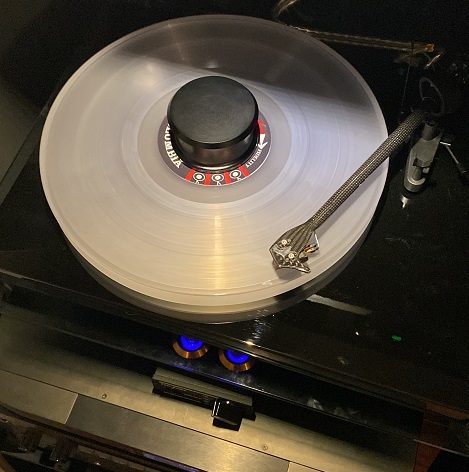Pro-Ject Debut Carbon Evo Review – Audiophile Cred On The Cheap
“I already pulled you out of one audiophile hole. Don’t make me pull you out of another.” That was the warning my editor gave me when I sent him pictures of my new Pro-Ject Debut Carbon EVO. I assured him that I wasn’t jumping down the audiophile rabbit hole. Maybe just a visit! But more on that in a bit.
Could the Pro-Ject Debut Carbon EVO be your next turntable? Priced at $599, it might just be; let’s discuss!
Under The Hood
The Pro-Ject Debut Carbon EVO has a lot going for it. It is an upgrade of their wildly popular Debut Carbon with an upgraded tonearm, gimbal, and motor support. Like its little brother, the Debut Carbon, the EVO does not have a built-in preamp, so you will need one on your receiver or bring your own.
Plinth
The plinth on the Pro-Ject Debut Carbon EVO is MDF and sits atop the three height-adjustable and rubber-damped aluminum feet, making leveling the plinth a snap. I think that adjustable feet are a no-brainer on a turntable. A heavy and level base is also a must-have when using physical media sensitive to vibration and wobble.

MDF is not anything mythical by any means; almost all plinths are made from MDF and then painted with different finishes. I think the gloss finish on this one is particularly nice though!
Tonearm and Cartridge
The tonearm on the Pro-Ject Debut Carbon EVO is carbon fiber. The lack of mass associated with carbon fiber and the upgraded gimbal allows the stylus to track easily across the record’s surface. The Pro-Ject Debut Carbon EVO is a manual turntable with a smooth manual cueing mechanism and drops the needle gently.
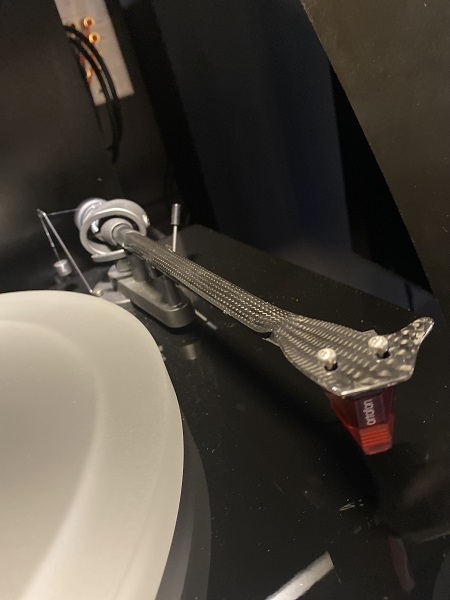
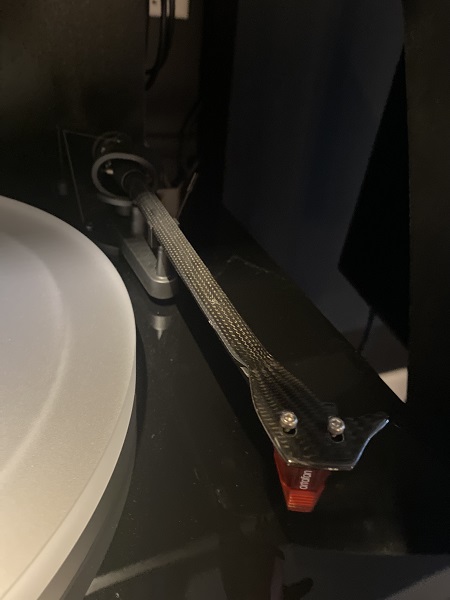
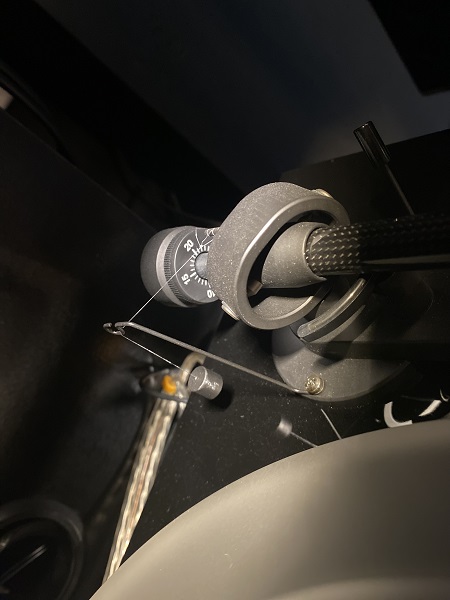
The Pro-Ject Debut Carbon EVO comes with different cartridges depending on your location. In Canada, it comes with the Ortofon 2M Red elliptical MM. In the USA, it will arrive with the Sumiko Ranier elliptical MM installed. I wish that Pro-Ject would give you some choice on a cartridge. I previously purchased the 2M Red and installed it on a Monolith turntable. But I ended up preferring the stock AT-VMN95E, and I returned it. So, I would have liked to try the Sumiko to expand my experience with different carts with the EVO.
Platter
The upgraded motor suspension and TPE (thermoplastic elastomer) damped, mass-loaded 1.7kg steel platter gives the Pro-Ject Debut Carbon EVO a smooth spin. I think it’s evident that Pro-Ject has taken painstaking steps to try and eliminate vibration from every element of the EVO. I appreciate this attention to detail. Pro-Ject makes their platter out of steel, damped with TPE (rubber). Steel is heavy, so add the TPE, and you are taking one extra step to reduce vibrations. Plus, once the heavy platter gets up to speed, inertia takes over and helps it spin without much effort.
You can also (as I did) opt for the Acrylic-It platter. Let me be clear here; there is no performance gained from acrylic. All the properties associated with acrylic (added mass and inertia) are the same as the steel. I like the contrast of the translucent platter against my gloss black plinth. So, the extra money spent is solely on aesthetics.
Motor
Pro-Ject has also upgraded the motor on the Debut Carbon EVO. Also upgraded are a new motor suspension and dampening system. These promise to reduce unwanted vibration from the spinning motor. Do you sense a trend here? Lastly, the Pro-Ject Debut Carbon EVO has an onboard speed control circuit that continually monitors and controls the motor speed to ensure smooth operation. I don’t know if this is clever marketing or a real need. My Monoprice doesn’t have any fancy speed circuitry, and I have never noticed a difference in speed.
I did a quick RPM check with a free app on my phone, and it confirmed that the DC carbon EVO did, in fact, track to within .5% of 33 1/3 RPM. Pro-Ject claims a wow and flutter of 0.17%, and it delivers!
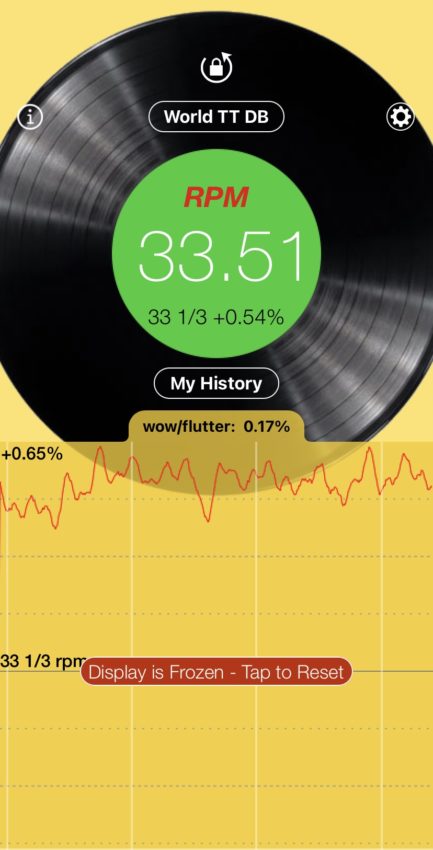
What’s In The Box?
The Pro-Ject Debut Carbon EVO comes well-packed with the platter, plinth/motor, and dust cover separated and secured. The first thing I noticed was the lack of excessive styrofoam. There were just two pieces for the plinth/motor assembly because of the weight, and everything else was heavy-duty cardboard. I like that Pro-Ject limits their non-recyclable materials to just a couple of pieces.
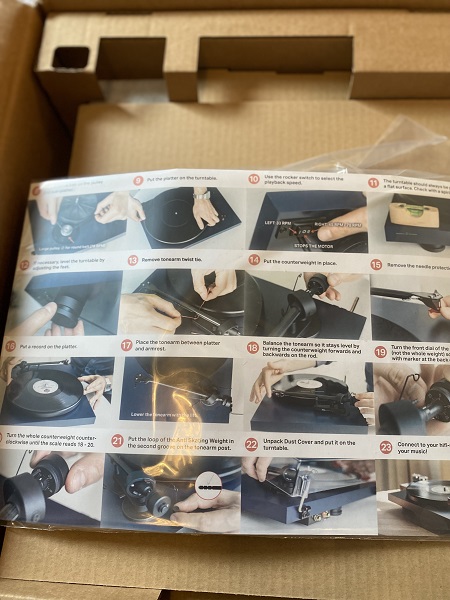
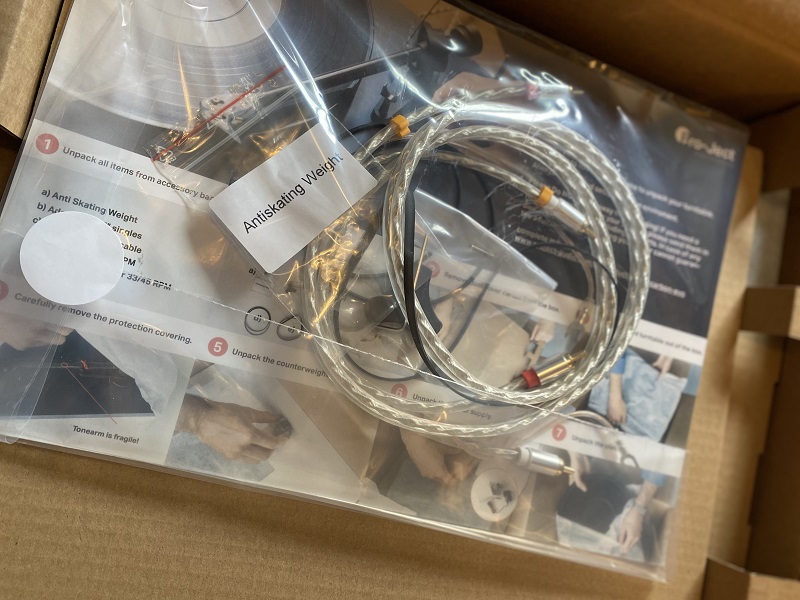

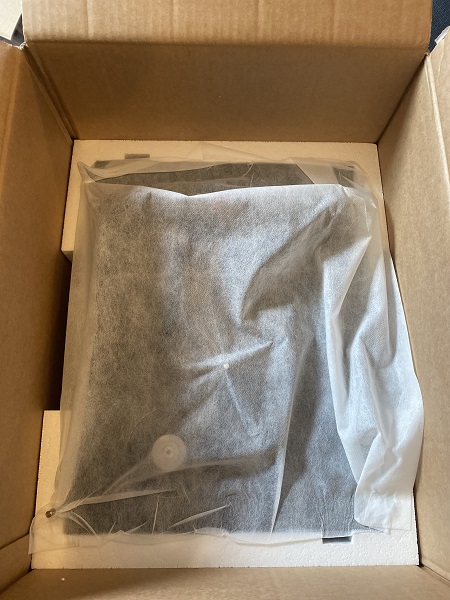
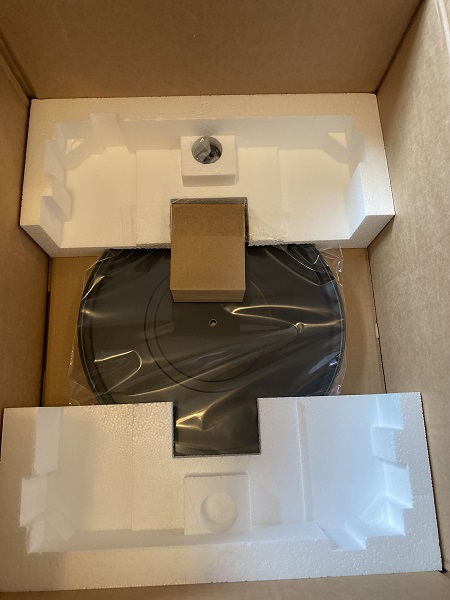
Another bag came with the instructions (didn’t need ’em), a 45 record adapter, a set of semi-balanced RCAs, belts, and the anti-skate weight. Pro-Ject tucked the tonearm counterweight in the styrofoam.
The Ortofon 2M red came preinstalled on the tonearm, so I didn’t have to worry about aligning it. But if you want to change out carts, the Pro-Ject Debut Carbon EVO comes with an alignment protractor. Remove the 2M Red, install the new one as per its instructions, and align away!
The Looks
Looks are subjective, but I think the Pro-Ject Debut Carbon EVO is very attractive. The plinth comes in five satin-finish colors, three in gloss, and a wood grain finish. There are no logos, graphics, or controls in sight. The power and speed selector are hidden on the bottom of the plinth, and there is nothing to tell you that this is a Pro-Ject turntable. I wish all component manufacturers would follow suit. It is simple and elegant.
I chose the gloss black plinth, although I would have preferred the satin. But, alas, the pandemic has gutted the supply chain, and it would have been a long wait for the satin. The finish on my turntable is superb. I shy away from gloss finishes because they are hard to do well. But Pro-Ject has done an outstanding job on this finish. There are no flaws anywhere, even on the bottom, where they would be easy to hide.
Setup
Setup on the Pro-Ject Debut Carbon EVO is beyond easy. Put the plinth on a level surface, then double-check with a bubble level. If you are out of level, the Pro-Ject Debut Carbon EVO comes with three adjustable feet that can move up or down to level the turntable plinth.
Grab the flat belt, and loop it around the correct pulley section and then around the sub-platter assembly. The round belt is for 78 RPM records; I doubt many people will need or use this. Drop the platter over the sub-platter, and you are almost ready to spin some vinyl.
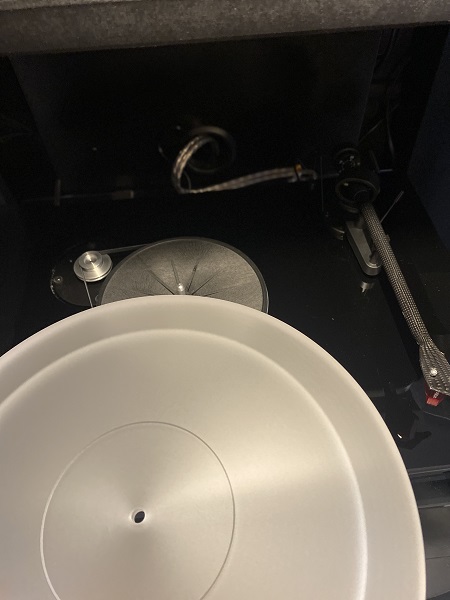
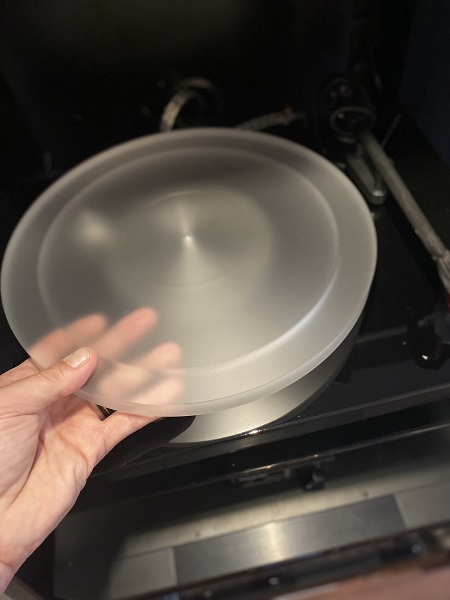
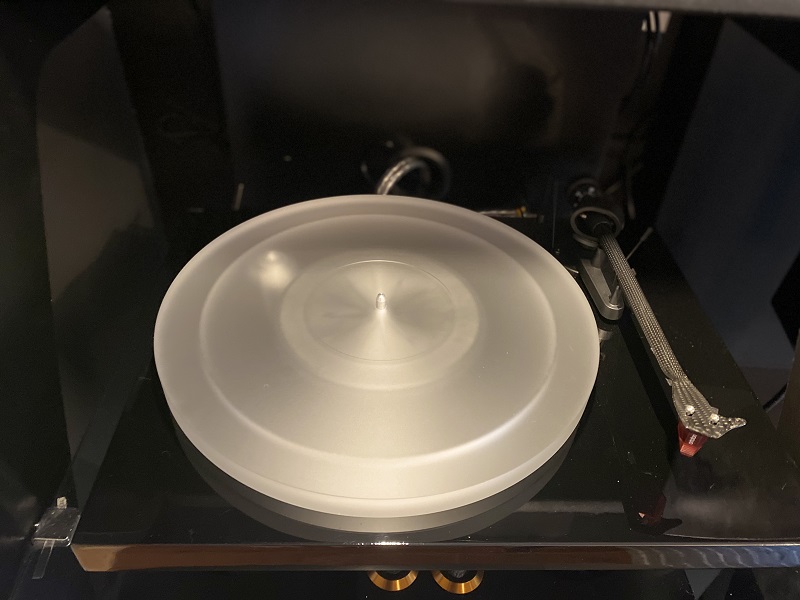
Setting the Tonearm
Grab your counterweight, pop it onto the end of the tonearm, and push it until you hear a click. Balancing the tonearm is pretty straightforward (if you have set up a few). Unlock the tonearm, remove the stylus guard, drop the queuing lever, and adjust the weight until the tonearm balances parallel to the plinth.
Caution is the name of the game here. Lowering the arm with the weight too far forward will slam it down on the player and damage your stylus. Take your time, and you will have the Pro-Ject Debut Carbon EVO set up in no time. If you are having trouble with this, Pro-Ject has a video on YouTube that walks you through the steps.
Once the tonearm is balanced, set the inner ring to zero, and then rotate the entire counterweight counter-clockwise until you are between 1.8 and 2.0g of tracking force for the included 2M Red cartridge. Or you could get yourself a stylus force-gauge and set it with that.
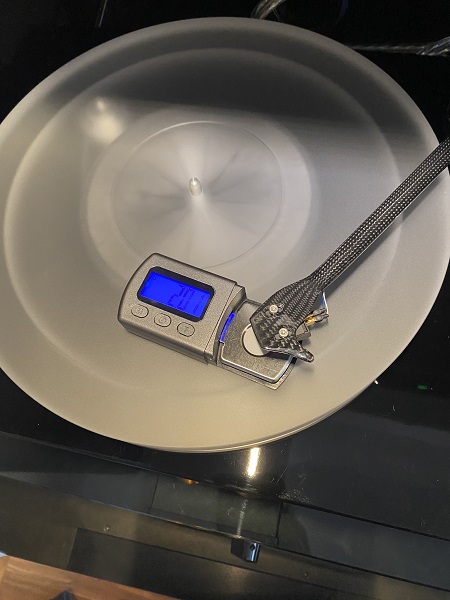
Connecting It
Lastly, plug your power and RCA cables into the back and connect to your receiver’s phono input or a dedicated phono preamp. Because the Pro-Ject Debut Carbon EVO doesn’t have a built-in phono preamp, you must have something to amplify and balance the signal from the EVO. I recommend the Fosi Audiobox X2. It was very inexpensive, and it has tubes!! I had to ground the EVO to my Audiobox to eliminate some hum. Thankfully Pro-Ject included a set of RCA cables with an integrated ground wire.
My Gear
I power my Paradigm 200Bs with an Onkyo NR-TX7100 AV receiver. Although the Onkyo has a built-in phono stage, I find it very low output, so I added the aforementioned Fosi Audiobox X2 as my phono preamp. This setup should pair very nicely with my new Pro-Ject Debut Carbon EVO.
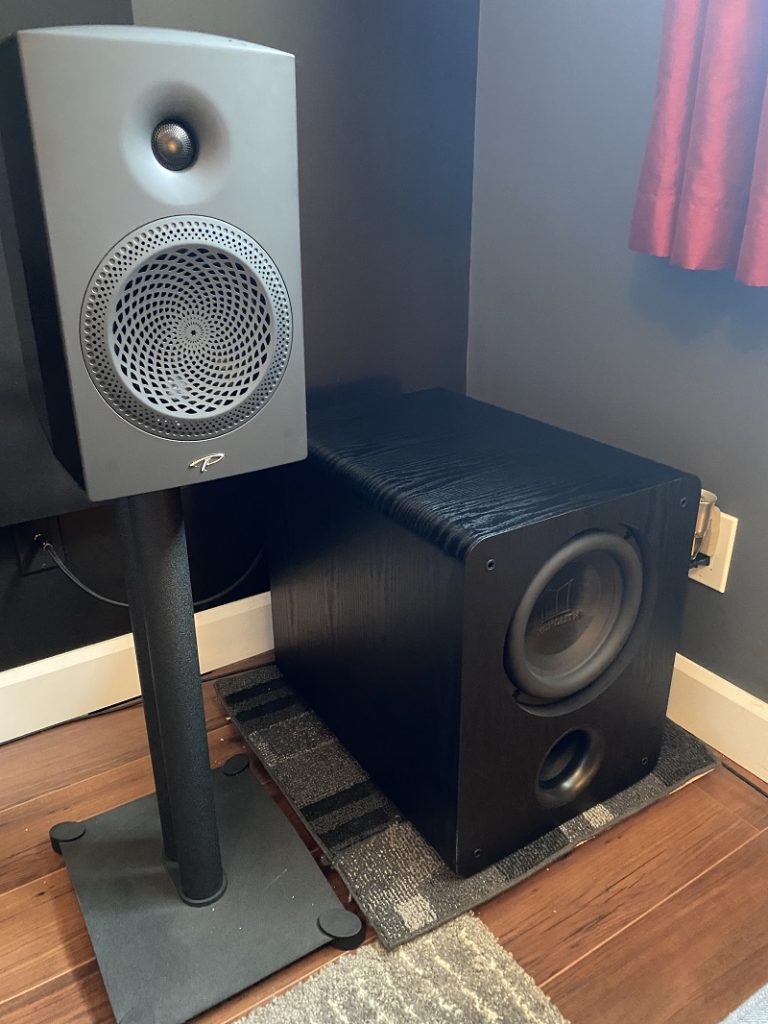
I augment my bass with a pair of 10″ ported subs, the Monolith M10 V2 and SVS PB1000. Both are level-matched and well placed, so I have no worries about bass.
Lastly, I have my room well-treated with acoustic panels. I have acoustic panels behind my main speakers, my first reflection points, and on my back wall (as we recommend). Many audiophiles eschew panels in favor of expensive speakers that might “overcome” their room issues. I prefer to treat my room because I understand that room acoustics are a real thing and that wishful thinking and throwing money at more expensive speakers will never work.
The Test!
Typically I choose a few test tracks and then break down my experience and impressions from each song. I chose tracks from multiple genres, including classic rock, jazz, blues, rap/hip-hop, and alternative. Plus, I have listened to them numerous times across CD, streaming, and LP, so I am very familiar with them. This familiarity allows me to concentrate on the quality of the playback.
I can concede that poor quality parts and fit/finish can impact the sound of the installed cartridge by adding vibration and other influences on the stylus. But let’s also be frank, we are using a physical medium that degrades with use. And LPs will be impacted by dirt on the LP and stylus, plus any slight warps. So we can never be sure why we hear imperfections in the playback.
So all of this is to say that the cartridge’s performance can impact or influence the sound with all the other factors eliminated. And because the Ortofon 2M Red is a well-reviewed cartridge, I suspect it will be a great-sounding performer. And yes, I said I owned a 2M Red and returned it, so keep reading.
The Results
I struggle the most with reviewing something on something as subjective as “how it sounds.” I bet that if you put five people and asked about their impression of the sound, you would get five different opinions. So many people prefer the sound of vinyl because it has a “warmer sound.” This warmness is nothing mythical, just the inherent lack of dynamic range associated with analog media. For me, there is also a lot of nostalgia factored in, which can play a solid psychological role.
As expected, there were no issues with the sound quality coming from the Pro-Ject Debut Carbon EVO. The plinth, platter, motor, and tonearm/gimbal didn’t impart any vibration (that I could detect) into the playback. Everything sounded as perfect as I could expect with physical media like LPs.
I wish I could gush more over the $599 turntable I just purchased. But in the end, it sounded great, but not magical. There is nothing I can complain about, though. The EVO did precisely what it was supposed to do and nothing more.
Cartridge Comparison
The Ortofon 2M Red is an excellent performer – full stop. It provided clear playback with outstanding stereo imaging and soundstage separation. And it compares well to CDs in terms of sound quality. The 2M Red performed noticeably better with new or well-cared-for used LPs. I found the 2M Red minded scratched or slightly dirty LPs more than the AT-VMN95E installed on the Monolith turntable. I don’t know enough about cartridge design to comment on why this happened.
“But Andrew, why don’t you install the AT-VMN95E on the Pro-Ject and compare?” Well, I did. It took me 30 minutes, some sweat, and cursing, but I did it in the name of science. And yes, I played back the same songs at the same volumes.
As I said earlier, I returned my previous 2M Red because I “liked” the AT-VMN95E more. After having the 2M Red for over a month and listening to various LPs, I can say that my perceived differences between the two carts are not as significant as I once thought. Psychology is entirely at play here. When I first got the 2M, I didn’t like it. Now, paired with a turntable that costs 3X more than my Monoprice, I like it? Sounds fishy!
But I think I figured it out. The 2M Red has a higher output than the AT-VMN95E. That means at the same volume setting on my AV receiver; the 2M is louder. Now most people like louder, but I am not one of them. I listen to my music at much more reasonable levels, so I think I preferred the lower volume of the AT-VMN95E. So once I brought the volume down on the 2M Red, it became more pleasing to my ear.
Value and Cred
Pro-Ject has been around since 1991, and the Debut Carbon line is still one of the best-selling turntables on the market. The few I saw on the used market still fetched a reasonable price. So this tells me that few people feel the need to upgrade, and when they do, they get most of their money back.
I think that’s important to note. The audio world is notoriously hard on used gear. It loses value quickly, so nothing is an “investment.” But I feel better about dropping that amount of cash on something I can probably recoup most of my money from if my interests change.
And remember when I said Audiophile cred on the cheap? I meant it. When I told other vinyl enthusiasts I had a Monolith turntable, they said, “oh, that’s nice.” But when I mention I have the Pro-Ject Debut Carbon EVO with the 2M AND acrylic platter…you get the drift. And yes, I agree that is a bit elitist, but I am at a place in my life where I can prioritize form over function, and I am willing to pay a premium to have what I want and not compromise.
My Take
So here is my final word. Is the Pro-Ject Debut Carbon EVO a good turntable? Absolutely. Its fit and finish are superb, and it feels, looks, and most importantly, sounds fantastic. Would you be happy if you purchased one? I think I am a very typical audio enthusiast, so I can say that most people would be pleased with this turntable. But, most importantly, is the Pro-Ject Debut Carbon EVO 3x’s better than the Monolith turntable? After all, the EVO is 3x the price! No, it’s not!
The law of diminishing returns hits quickly in the audio world. The Monoprice turntable has a built-in preamp plus USB and Bluetooth connectivity that the EVO lacks. And I think that the Monoprice has 90% of the performance of the Pro-Ject Debut Carbon EVO. And that’s a hard pill to swallow for someone who dropped $599 (plus the acrylic platter) on a turntable that is not remarkably better.
But the Pro-Ject Debut Carbon EVO will be my primary turntable for the foreseeable future. That 10% difference comes from a high-quality finish, a more elegant and minimalist design, and a more substantial tonearm mated to a smoother tracking gimbal. Plus, it just looks more audiophile. Add that the EVO will hold much more of its value and I don’t regret my purchase.
So if you want to step up from an entry-level turntable and have the means to spend $599 on a turntable, I highly recommend considering the Pro-Ject Debut Carbon EVO. I don’t think you will be disappointed.

